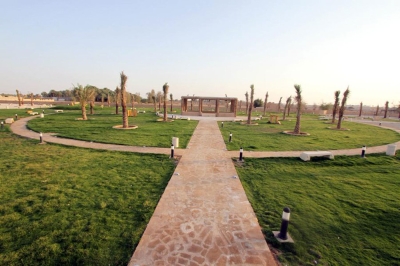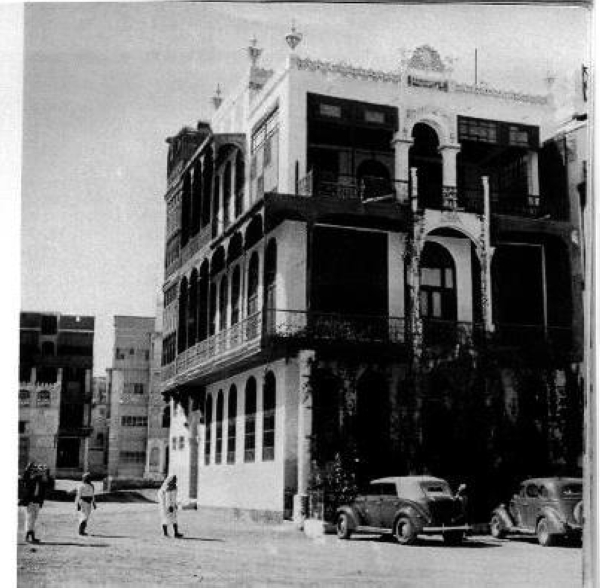
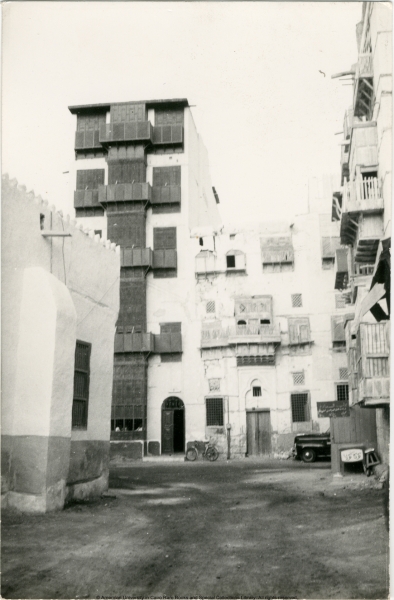
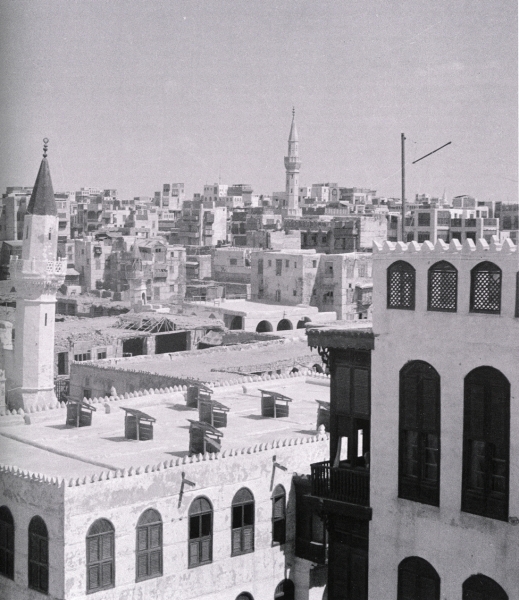
Historical Jeddah, or al-Balad, is a world cultural heritage site, a central archaeological, commercial, and tourist area, in downtown Jeddah on the western coast of the Kingdom of Saudi Arabia. It consists of the Jeddah neighborhoods within the old wall, gates, alleys, mosques, houses, markets, buildings, government headquarters, neighborhood empty areas between houses (barha), landmarks, public squares, personal museums, and ancient mosques. Historic Jeddah is one of six Saudi archaeological sites listed in the United Nations Educational, Scientific and Cultural Organization (UNESCO)’s World Heritage List.
Historic Jeddah is surrounded by a wall that was first built in the fifteenth century. Within it, Historic Jeddah was divided into four main neighborhoods (Harat): Harat al-Sham (the Levant), Harat al-Yemen, Harat al-Mazloum, and Harat al-Bahr (the sea). These neighborhoods contained landmarks that influenced modern Saudi history, most notably: Bait Nassif (House of Nassif), in which the founding King Abdulaziz Bin Abdulrahman Al Saud resided for about ten years, as well as four hundred buildings; the oldest of which dates back to the seventh century, and the most recent to the twentieth century.
Historic Jeddah Rejuvenation Project
In 2021, Crown Prince and Prime Minister, His Royal Highness Prince Mohammed Bin Salman Bin Abdulaziz Al Saud, launched the Historic Jeddah Rejuvenation Project to transform the district into an integrated area that fuels the economy, contributes to the growth of gross domestic product (GDP), and achieves the objectives of Vision 2030. In 2022, approval was given to establish the Jeddah Governorate Development Authority.
Visiting Historic Jeddah is a keenly observed ritual by Jeddah locals during the Eid seasons and the month of Ramadan. The district annually hosts the Historic Jeddah Festival, which is a heritage and cultural event, that draws more than half a million visitors.
History of Historic Jeddah
Historic Jeddah represents the historical depth of the city of Jeddah, dating back hundreds of years before Islam, and its economic significance and status were underpinned by virtue of being the gateway to Makkah al-Mukarramah since 647. Caliph Uthman Bin Affan (may Allah be pleased with him) had made Jeddah a major port for receiving pilgrims headed to the Holy Sites in Makkah al-Mukarramah, and it continues to play this strategic role – alongside its role as a commercial port on the Red Sea coast – until today.
Historic Jeddah before Islam
Historic Jeddah is about three thousand years old, when it first appeared as a locale for fishermen after their fishing trips across the Red Sea. Over time, Jeddah burgeoned into a human settlement where trade, fishing, construction, and a variety of handicrafts flourished.
Historic Jeddah in the Islamic age
Historic Jeddah’s economic significance and status increased by virtue of being the gateway to Makkah al-Mukarramah since 647. Caliph Uthman Bin Affan (may Allah be pleased with him) had made Jeddah a major port for receiving pilgrims headed to the holy sites in Makkah al-Mukarramah, and it continues to play this strategic role – alongside its role as a commercial port on the Red Sea coast – until today.
Historic Jeddah in the Saudi era
In the Saudi era, Historic Jeddah received attention from Saudi leaders since the establishment of the Kingdom until our present time. The founding King Abdulaziz Bin Abdulrahman Al Saud settled there in 1925, where he resided in Bait Nassif for about ten years. He also set up his majlis (sitting place) and a musalla (praying area) next to al-Hanafi Mosque.
Since 1977, Historic Jeddah has been bustling with development, restoration, paving, and lighting activity, which coincided with the founding of its old municipality, and was followed by the preparation of development schematics, then implementation works, beginning in 1980 and until 1984. Later, in 1992, a government department was established for the protection of buildings in Historic Jeddah from encroachment. Between 2012 and 2019, an estimated SAR270 million were earmarked for the area’s conservation and development. The King Abdulaziz Project for the Conservation of Historic Jeddah, The Custodian of the Two Holy Mosques Program for Attention to the Cultural Heritage of the Kingdom, and the Historic Jeddah Rejuvenation Project are the most prominent projects that preserved Historic Jeddah’s building landscape and revived tourism in the district.

UNESCO World Heritage List
Council of Ministers Decision No. 5455 dated August 13, 2006, approved the registration of three historical sites in the Kingdom in the UNESCO’s World Heritage List, namely: Hegra, Historic Diriyah, and Historic Jeddah. Two years prior to the Council of Ministers decision, the Municipality of Jeddah began – in collaboration with a multitude of government entities– to translate the leadership's attention to Historic Jeddah into action plans and projects, primarily aimed at preserving the historic district of Jeddah to remain the city’s beating historical heart. This was implemented through the preparation of construction blueprints and code that preserves the historical idiosyncrasy of the area, classifying historic buildings, paving streets with stone, and lighting them with traditional lanterns. Consequently, a government agency was established and tasked with the conservation and maintenance of ancient buildings in Historic Jeddah.
The listing of Historic Jeddah was put to a vote by the World Heritage Committee at its thirty-eighth session, held in Qatar in 2014, where it was adopted among the World Heritage List on Saturday, June 21, 2014, and the site was included in the United Nations Educational, Scientific and Cultural Organization (UNESCO)'s World Heritage List.
Development of Historic Jeddah
Ever since King Abdulaziz’s visit in 1925, Historic Jeddah has been bustling with development, restoration, paving, and lighting activity. The administrative, economic, and scientific organizations of Jeddah were established, and in 1927, King Abdulaziz Al Saud ordered the import of two large seawater desalination units, after the Kindasa distillery broke down, and spring water from Wadi Fatima al-Jumum was delivered to Jeddah in 1947. It was dubbed al-Ain al-Aziziya after its founder, King Abdulaziz.
The Historic Jeddah Municipality was founded in 1980, and the Historic District Protection Department was established at the Municipality of Jeddah Governorate in 1991, and later became the Historic District Protection Directorate. In 2005, the King Abdulaziz Project was founded to preserve Historic Jeddah, and a department was formed to oversee the development and modernization works of Historic Jeddah.
Restoration of fifty-six buildings in Historic Jeddah
In 2018, the Custodian of the Two Holy Mosques King Salman Bin Abdulaziz Al Saud issued a royal decree ordering the establishment of an independent department, with an independent budget, titled the Historic Jeddah Project Department, under the Ministry of Culture, based on what was presented by the Crown Prince and Prime Minister, His Royal Highness Prince Mohammed Bin Salman Bin Abdulaziz Al Saud, Head of the Grand National Projects Committee.
In 2019, Prince Mohammed Bin Salman Bin Abdulaziz ordered SAR50 million (initially) to be paid to support a project to restore fifty-six dilapidated buildings in Historic Jeddah, which bear rich architectural elements of Jeddah’s historical heritage. The Crown Prince’s gesture comes to support projects centered around the preservation of the Kingdom's historical and civilizational gains.
Historic Jeddah Rejuvenation Project
The Historic Jeddah Rejuvenation Project is part of the Historic Jeddah Development Program, which focuses on developing livelihoods in the district, transforming it into an area that houses its ancient heritage monuments, and capitalizing on its locations and cultural and urban sites. The aim is to improve the quality of life and preserve these sites as a cultural legacy that reflects the identity and nature of the district, and to promote urban aspects, in order for Historic Jeddah to become a to be a global attraction in the Kingdom. Project works are scheduled to be completed over fifteen years, pursuant to an array of paths and plans.
Works at the Historic Jeddah Rejuvenation Project are proceeding in a number of paths, including infrastructure and services, strengthening urban aspects, improving and increasing the efficiency of quality of life, and developing and preparing the environmental and natural domain by highlighting the historical features of Jeddah. These features comprise thirty-six historical mosques, more than six hundred heritage buildings, five major historical markets, as well as courtyards, passageways, and sites of important historical significance.
The project includes the creation of an entire environment with natural spaces, including open gardens and green spaces covering 15 percent of Historic Jeddah's total area, and waterfronts up to fifteen km long.
Old Jeddah Wall
Historic Jeddah is surrounded by a wall built as part of its fortification and protection from Portuguese warships, consisting of eight gates (babs), namely: Bab Makkah, which opens to the Makkah al-Mukarramah side; Bab al-Madinah; Bab Shareef; Bab al-Sabbah; Bab al-Maghariba; Bab Suraif; and Bab al-Nafe’a; as well as the new door built by founding King Abdulaziz Al Saud. In 1947, the wall overlapped with the expanding city's buildings, which led to it being demolished. Some of his gates, however, remain to this day, such as Bab Makkah and Bab Jadeed.
History of Jeddah’s Old Wall and gates
The wall surrounding Historic Jeddah was first built in the fifteenth century, on the orders of Sultan Abu al-Nasr Qansuh al-Ashraf Qaitbay, the last of Egypt’s Burji Mamluks Sultan in 1509. He commissioned it to be built by one of his leaders, Hussein al-Kurdi, as part of Jeddah’s fortifications to protect it from Portuguese warships. He began fortifying the wall by building forts and towers, installing cannons, and also encircling the wall from the outside with a trench that further immunized the city against hostile attacks.
Construction of the Jeddah Old Wall
The wall of Historic Jeddah was built with the help of the people of Jeddah. The wall consisted of seven gates built in stages, as necessary: Bab Makkah, Bab al-Shareef, Bab al-Sabbah (also called Bab al-Bunt), Bab al-Maghariba, Bab al-Nafe’a, and Bab al-Madinah. Later, during the Saudi era, a new gate was added on the northern side of the Historic Jeddah wall, named Bab Jadeed.
Northern wall gates
The gates of the North Wall consist of:
Bab al-Madinah: located north of the District Administrator Headquarters’ Park in Harat al-Sham, facing Bait Bajnaid on the east side, with a wide street separating the park and the gate that later became part of King Abdulaziz Ring Road. The gate was used for several purposes, including: access to al-Qashla, which is the military barracks that still survives to date, used by travelers to and from al-Madinah al-Munawwarah, as well as travelers to and from Makkah al-Mukarramah. It was also used for the passage of stone-laden carriages extracted from the quarries north of the city of Jeddah, and mud extracted from the Sea of Mud, nowadays known as Lake al-Arbaeen, which was used in the construction of Jeddah's homes at the time.
Bab Jadeed: one of the gates of the northern wall and the last of the gates built on the wall at the beginning of the Saudi era, located east of Bab al-Madinah, facing Bait al-Hazzazi, and comprises a double gate wide enough for cars to cross through.
Eastern wall gates
Bab Makkah: which is Jeddah’s entrance from the eastern side, and is located in front of Souq al-Badu (Bedouin Market) and leads to al-Haraj and al-Halaqat markets outside the wall, and is a crossing for funerals heading to al-Asad Graveyard, located outside the wall.
Southern wall gates
Bab al-Shareef: which is Jeddah’s entrance from the southern side, located in front of Barhat al-Aqili. It leads from the outside to Haraj al-‘Asr marketplace where locals went to shop outside the wall. The gate also leads to an area called Qawz or al-Hamla, which is a high knoll that served as a breathing space for the people of Jeddah, especially the elderly, as it overlooked Barhat Bab al-Shareef and Haraj al-‘Asr, as well as a juncture connecting al-Balad with the neighborhoods of Bisha, Barra, and others.
Western wall gates
The West Wall consists of several gates:
Bab al-Nafe’a: the first gates of the main western wall from the south side, also called Bab al-Farda, located in the southern part of Burj al-Mahmal site opposite to al-Mahmal Shopping Center on King Abdulaziz Street. This gate used to serve as a crossing point for those working at Souq al-Bunt or in the sea, mostly residents of Harat al-Bahr and Harat al-Yemen.
Al-Sabbah: this is the second gate of the West Wall and the most important, as it was surrounded by several important government departments, such as the municipality from the north, the postal and telegram departments, and the police station, from the south, and the courthouse above it. The door got its name because imported grain was poured there, sieved and placed in bags, and then weighed by a weighbeam, in preparation for transfer to merchants' warehouses. The gate is situated at the entrance to Souq al-Bunt or the so-called Barhat Akkash Mosque from the side of the Western al-Bunt Square.
Bab al-Maghariba: is the third gate of the West Wall, located just south of al-Jafali Building on present-day King Abdulaziz Street. This gate was the only exit for pilgrims arriving by sea en route to Makkah al-Mukarramah and al-Munawwarah through Bab al-Madinah.
Bab Suraif: is the secondary gate on the West Wall, also known as Bab al-Arbaeen, located between the Red Sea Hotel Building and al-Salhiya Building (presently al-Faisaliyah Building).
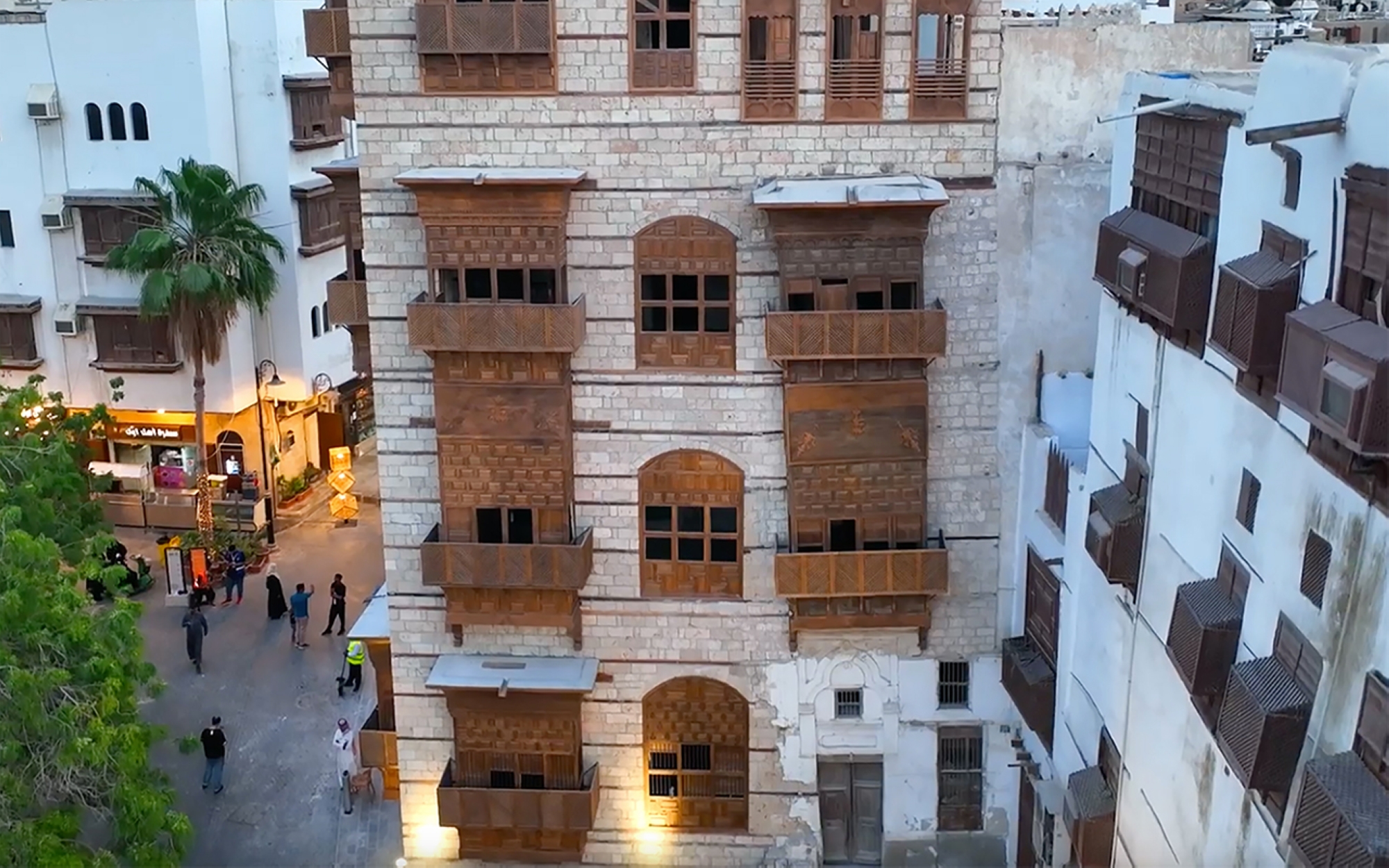
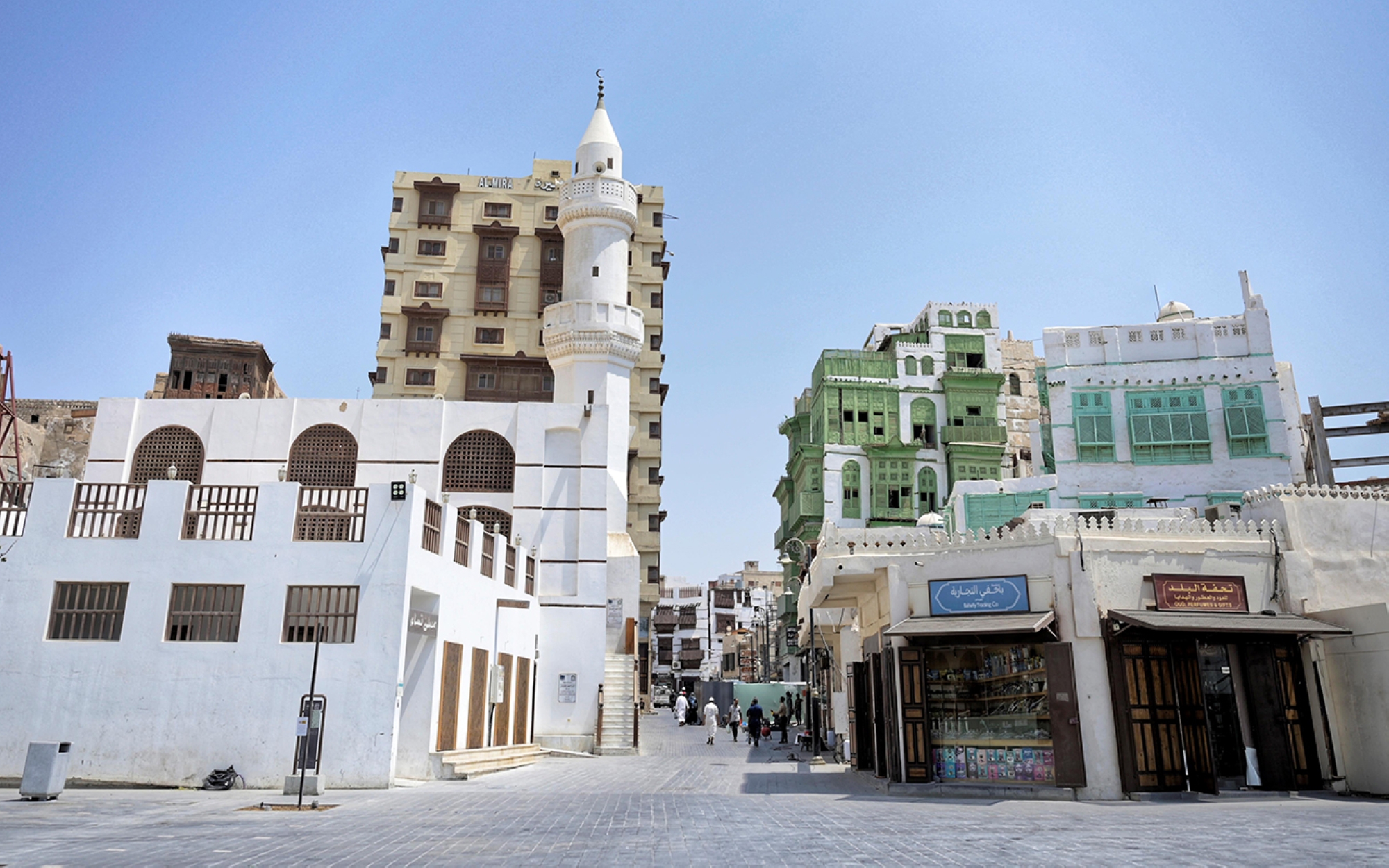
Neighborhoods of Historic Jeddah
After the removal of the Historic Jeddah Wall to make way for urban expansion in 1947, the city of Jeddah within the wall was divided into several neighborhoods, previously known as harat (alleys). These neighborhoods got their names according to their geographical location within the city or due to momentous events that took place within them: Harat al-Sham, Harat al-Yemen, Harat al-Mazloum, and Harat al-Bahr. These neighborhoods included landmarks that influenced the march of modern Saudi history, among them: Bait Nassif, as well as al-Falah School, the first school founded in Hijaz, thirty-three years before the unification of the Kingdom, which opened in 1905, and is today one of the most important sites in Harat al-Mazloum. They also included the oldest mosques in the city of Jeddah, such as the 1400-year-old al-Shafei Mosque, located in Harat al-Mazloum, al-Mimar Mosque, built in 1682, and Uthman Bin Affan Mosque.
Harat al-Yemen
Harat al-Yemen was established within the walls of Historic Jeddah, located to the south from within the wall, south of al-Alawi Street. It got its name from the fact that it faced the direction of Yemen. The most important features include Dar al-Nassif, Dar al-Jamjoom, Dar al-Shaarawi, and Dar al-Abdualsamad.
Harat al-Bahr
Harat al-Bahr was built within the walls of Historic Jeddah and is located in the southwestern part of the city of Jeddah, overlooking the Red Sea, hence, its designation. Among its most prominent features is Dar al-Radwan, then known as the Radwan al-Bahr.
Harat al-Mazloum
Harat al-Mazloum (the alley of the wronged) is one of the neighborhoods falling within the walls of Historic Jeddah. Its name derives from the story of the killing of Mr. Abdulkarim al-Barzanji, who was unjustly killed by the Ottoman Government. Harat al-Mazloum is situated in the northeastern part of the wall, north of al-Alawi Street, and contains a number of features, most prominently: Dar al-Qabil, al-Shafei Mosque, and Souq al-Jami.
Harat al-Sham
Harat al-Sham is one of the neighborhoods within the walls of Historic Jeddah, named after its direction facing the Levant. It is located in the northern part of the wall, and includes a number of prominent features, chiefly: Dar al-Sarti and Dar al-Zuhd.
| Neighborhoods of Historic Jeddah | Most prominent monuments |
|---|---|
| Harat al-Yemen. | Dar Al Nassif. |
| Dar al-Jamjoom. | |
| Dar Al Shaarawi. | |
| Dar Al Abdulsamad. | |
| Harat al-Bahr. | Dar Al Radwan. |
| Harat al-Mazloum. | Dar Al Qabil. |
| Al-Shafei Mosque. | |
| Uthman Bin Affan Mosque. | |
| Al-Falah School. | |
| Souq al-Jami. | |
| Harat al-Sham | Dar al-Sarti. |
| Dar al-Zuhd. | |
| Al-Basha Mosque. |
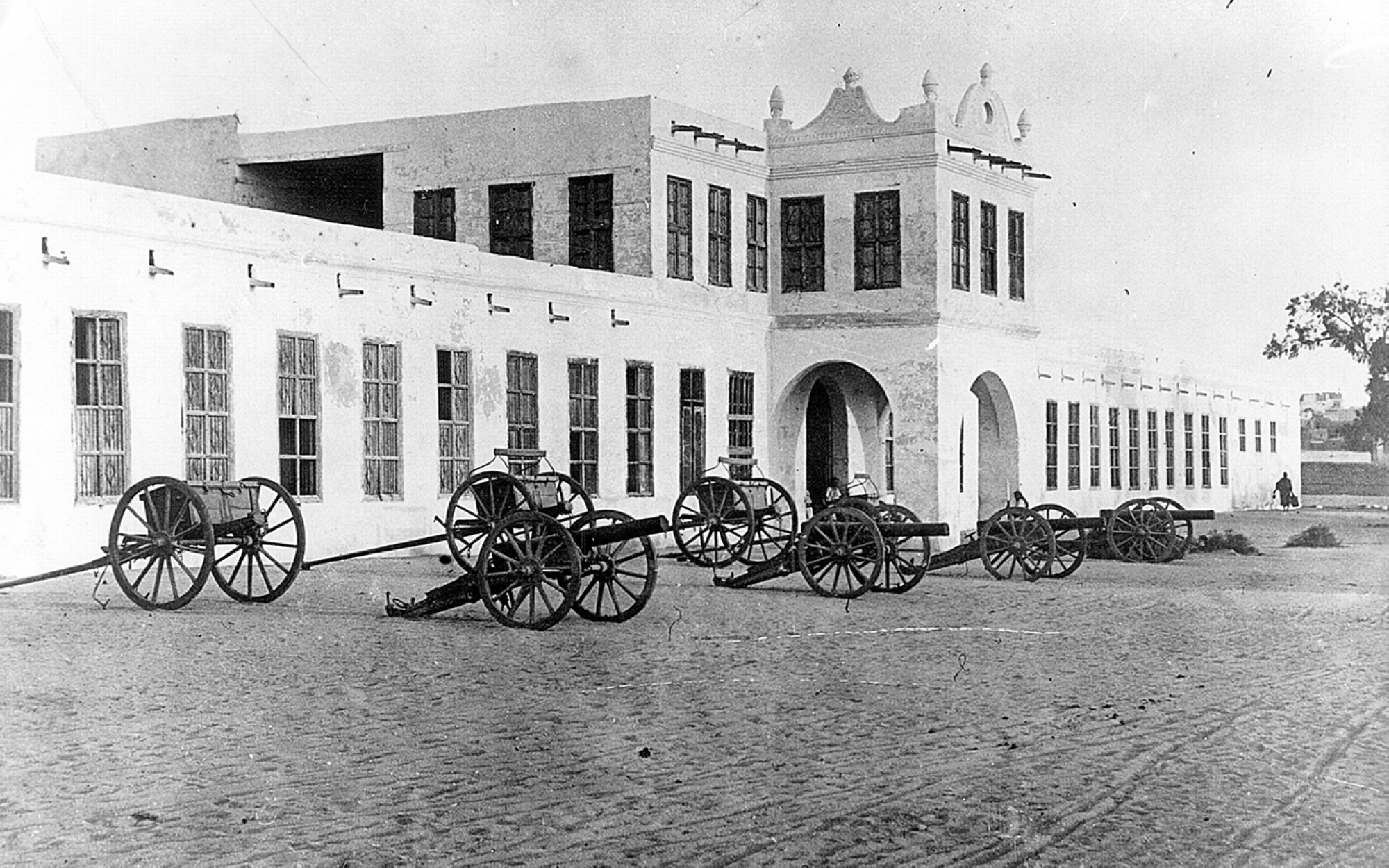
Houses in Historic Jeddah
Historic Jeddah contains around six hundred archaeological buildings, the oldest of which dates back to the seventh century, and the most recent to the twentieth century. Most of these buildings were built according to the architectural style prevalent in the Red Sea basin, which relies on sea clay and prospected stone, wood for doors and windows, and separate Rawashin with brown, green, and blue paint, in addition to newly constructed buildings built with modern construction materials. Among the most famous and oldest buildings that survive until today are: Dar al-Nassif and Dar al-Jamjoom in Harat al-Yemen; Dar al-Baeshen, Dar al-Qabil, and al-Shafei Mosque in Harat al-Mazloum; and Dar al-Banajah and Dar al-Zuhd in Harat al-Sham.
Construction of houses in Historic Jeddah
Houses in Historic Jeddah used to be built from prospected stone, which locals extracted from Lake al-Arbaeen (or what was then called the Mud Lake), before using manually operated contraptions to modify it and then placed it in suitable molds of specific sizes, along with timber that reached them from nearby areas, such as Wadi Fatima, or what they imported from abroad via the seaport (particularly from India). In addition, they used the mud they brought in from the Sea of Mud in the stabilization prospected stone and oversailing bricks.
Construction of houses in Historic Jeddah was by oversailing stone in courses of masonry punctuated by wooden separators, called wreaths, for the distribution of load to almost every meter of walls. Ancient buildings are very similar to modern concrete building, and timber to a large extent represent the exterior walls of the concrete structures, so as to relieve weights by using wood. Thanks to the durability and quality of construction, some houses maintained their cohesion and original design until today, due to the way which they were built that made them survive intact dozens for decades.
A distinctive feature of these houses is the presence of windcatchers above all rooms, the use of Rawashin in large sizes, and ornamented wood on the walls to help with air distribution and circulation throughout the house, in addition to casting shadows on the walls of the house to contribute to lowering temperatures. Houses were also lined up in a zigzag formation next to each other, so that their facades would cast shadows over one another.
Prominent houses of Historic Jeddah
Bait Nassif, built in 1872, with an architectural design that bears the features of Hijazi architecture and took four years to build, is one of the most important heritage houses in Historic Jeddah. It derives its historical significance from the fact that the founding King Abdulaziz Bin Abdulrahman Al Saud resided there for ten years in 1925. In addition, King Abdulaziz received the pledge of allegiance from the people of Hijaz in that house, and also received State guests there, alongside a number of presidents, scholars, intellectuals, litterateurs, and dignitaries. The house included a library that contained thousands of books in the field of humanities, which was later gifted to King Abdulaziz University,following the death of Omar Nassif.
Bait al-Matbouli is one of the houses in Historic Jeddah, which dates back more than four hundred years. Built in the style of Hijazi architecture, it is considered a model of old Jeddah houses. The house consists of four floors, decorated with ornate wood on its walls and high ceilings, which have greatly helped with air circulation to milden temperatures. The house has two separate entrances, two seating areas, and more recently, al-Matbouli descendants spent almost one year restoring the house, and managed to return its furniture and architectural details to their original glamor as a civilizational facade of Jeddah.
Bait al-Sharbatlywas built in 1916 by Sharif Abdullah al-Abdali, and was formerly the official headquarters of the Embassy of the Arab Republic of Egypt in the Kingdom, and has now been turned into a cultural center and venue for art exhibitions and cultural events. It consists of four floors, and is famous for its white columns and wooden windows and balconies.
Bait Qabil is an archaeological house in Harat al-Mazloum, in Historic Jeddah, whose construction is distinct for its high ceilings, as this helped in the olden days with air circulation and purification. The house derives its significance from its location on Qabil Street; the first street to be lit with electrical lights in the city of Jeddah.
Bait Zainal is located in Harat al-Yemen next to al-Mimar Mosque, and was formerly the headquarters of the Embassy of the Netherlands in the Kingdom; hence, it was dubbed Bait Zainal of Holland. It is one of the most ancient concrete buildings in the Historic Region.
Bait al-Batterjee was the first headquarters of the Embassy of the United States in Jeddah. Located in Harat al-Mazloum, it consists of three floors and stand apart by its colors and the thickness of its construction. Bait al-Batterjee opens its doors to tourists and visitors; showcases photographs on its walls highlighting its historical significance, and contains a number of historical exhibits, including the first Saudi phone bearing the emblem of two swords and a palm tree.
Bait Nour Wali is a unique architectural model in Historic Jeddah, built by Mahmoud al-Sabban and then sold in 1946 to Abdulqadir Nour Wali; hence his name. The house is characterized by its green windows that protrude outwards, comprised of Rawashin stamped with tremendously intricate bas-reliefs.
Bait Baeshen was built in 1822 and is one of the oldest archaeological houses in Historic Jeddah, dating back two hundred years. It consists of three floors and is currently a museum showcasing the time period to which the house belongs. It includes a library, artifacts, photographs, manuscripts, currencies, and postage stamps, and the walls of its majlises are covered with Holy Quranic verses by Holy Quran calligrapher Mohammad Tahir Kurdi, as well as by calligrapher Asaad Mohammad Habbal.
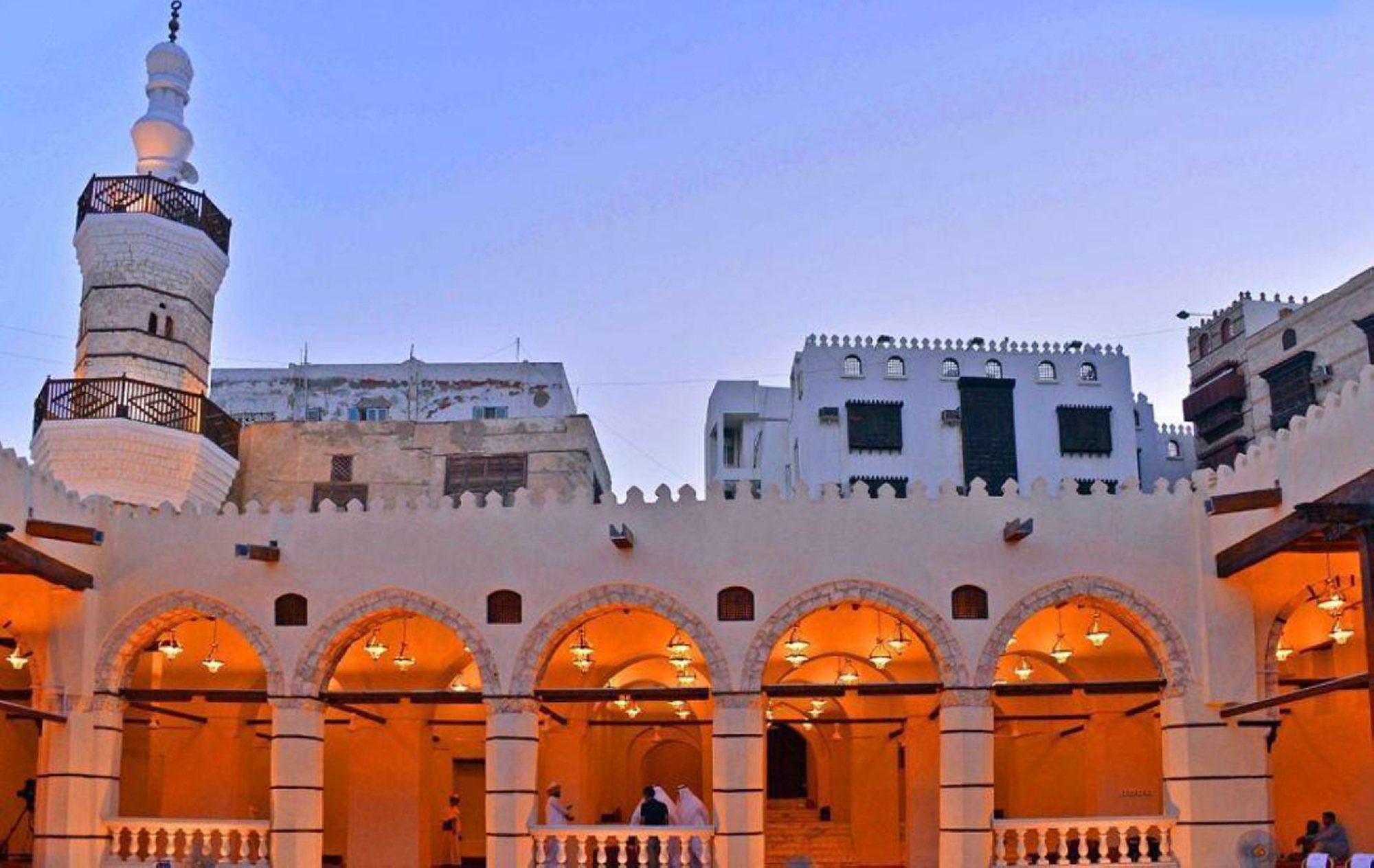
Mosques of Historic Jeddah
Historic Jeddah embraced many historical mosques, such as al-Shafei Mosque in Harat al-Mazloum, which dates back to the early age of Islam; al-Mimar Mosque built in 1682; and al-Abanous (Ebony) Mosque, now known as Uthman bin Affan Mosque; and al-Hanafi Mosque, where the founder King Abdulaziz Bin Abdulrahman Al Saud prayed, which dates back to 1825.
Most prominent mosques
Al-Shafei Mosque is one of the highlights of Harat al-Mazloum in Historic Jeddah, whose importance derives from its ancientry and as it is considered to have witnessed the first centuries of Islam. It was built during the era of Caliph /umar bin al-Khattab (may Allah be pleased with him), using traditional materials such as wood, sea mud, and prospected stone, which were the main construction materials used by Jeddah locals at the time. Al-Shafei Mosque underwent a comprehensive restoration, and the Custodian of the Two Holy Mosques King Salman Bin Abdulaziz Al Saud dedicated special attention to it, following up on the different stages of its development in 2014 (when he was Crown Prince), during his visit to Historic Jeddah. Restoration works were completed and the mosque was reopened in 2015.
Al-Mimar Mosque, in Harat al-Mazloum, one of the neighborhoods of Historic Jeddah, is located on al-Alawi Street west of Mahallat al-Mazloum, near the renowned Barhat Nassif, dating back to 1682. In 2018, it was reopened upon the completion of restoration works at the expense of King Abdullah Bin Abdulaziz Endowment.
Al-Basha Mosque, one of the mosques in Harat al-Mazloum in Historic Jeddah, was built by Bakr Basha, who was the governor of Jeddah in 1735. It is one of the oldest mosques built in Historic Jeddah. It is famous for its minaret which gave the city an architectural archaeological landmark and remained intact until 1978, when the mosque was demolished and a new one was erected.
Uthman Bin Affan Mosque, constructed between the fifteenth and sixteenth centuries, is also known as the Ebony Mosque, after two ebony pillars inside the mosque, and is one of the mosques in Historic Jeddah mentioned by Ibn Battuta and Ibn Jubeir in their travelogues.
Akkash Mosque, built in 1786, is located in Harat al-Mazloum on Qabil Street from the west side. It was built on a raised platform above street level, climbed to by five steps made of old walnut hardwood distinct for its burnt brown color, and the mosque still retains its original building, and prayers are regularly held in it.
Prince Mohammed Bin Salman Project for the Development of Historical Mosques
By virtue of being one of the most important features of civilizational architectural heritage and their authentic architectural features representative of their historical, cultural, and social depth, the Prince Mohammed Bin Salman Project for the Development of Historical Mosques, in its second phase, reconstructed and renovated historical mosques in Jeddah. The project aims to enhance the religious and cultural status of historical mosques, as underlined by Vision 2030, by preserving their authentic architectural features and utilizing them in the development and design of modern mosques.
The second phase of the project involved the rehabilitation and development of Abu Inabah Mosque, located in Harat al-Sham in Historic Jeddah, which dates back more than nine hundred years, and spans an estimated area of 339.98 m with a capacity of 360 worshippers. Rehabilitation works include increasing the mosque’s total area to 335.31 m and amending its capacity to 357 worshipers, in accordance with effective methods for preserving the importance of the mosque’s historical legacy, in order to resemble its original image as much as possible. The project also aims to restore and rehabilitate al-Khader Mosque, located in al-Balad, which dates back seven hundred years, and occupies an estimated area of 357.53 m, with a capacity of 372 worshipers, by amending its area to 355.09 m and its capacity to 355 worshipers.
Old markets and small shops
Historic Jeddah has long been known for its markets that contributed to forming the district’s vital economic vein, including markets that still exist to our present day, such as al-Badu Market, located in Bab Makkah and dating back more than 140 years, where bedouin residents are able to purchase all that they need; al-Nada Market, which is more than 150 years, and mostly contains shops selling shoes; and Qabil Market.
Historic Jeddah also includes some specialized markets, including the Fish Market (Banqala); toward the end of Qabil Street to the east, lies a vegetable and butchery market in al-Nowariya, which also included al-Souq al-Kabeer, comprised of large and small shops packed with all kinds of fabrics; al-Khaskeya Market, located behind Sheikh Mohammad Nassif's House; al-Habbaba Market, located in Bab Makkah; al-Jami Market, relative to al-Shafei Mosque; and al-Haraj Market in Bab al-Shareef. Also in Bab al-Shareef, al-‘Asr Market is located that was daily held back then after ‘Asr prayer; al-Baraghiya Market, which specialized in making saddles for donkeys, mules, and horses, located at al-Sharbatly Building.; in addition to al-Subahiya Market, dedicated to the sale and manufacture of misbahas (prayer beads).
Historic Jeddah also included a number of small shops, known as khans or Qisarya (Caesarean), which refer to a market with rows of shops opposite that open and close facing one other. One of Historic Jeddah's most prominent khans is Khan al-Qasba; a marketplace for fabrics and textiles; Khan al-Hunood (Indians); Khan al-Dallaleen (middlemen); and a Khan al-Attareen (perfumers).
Tourism in Historic Jeddah
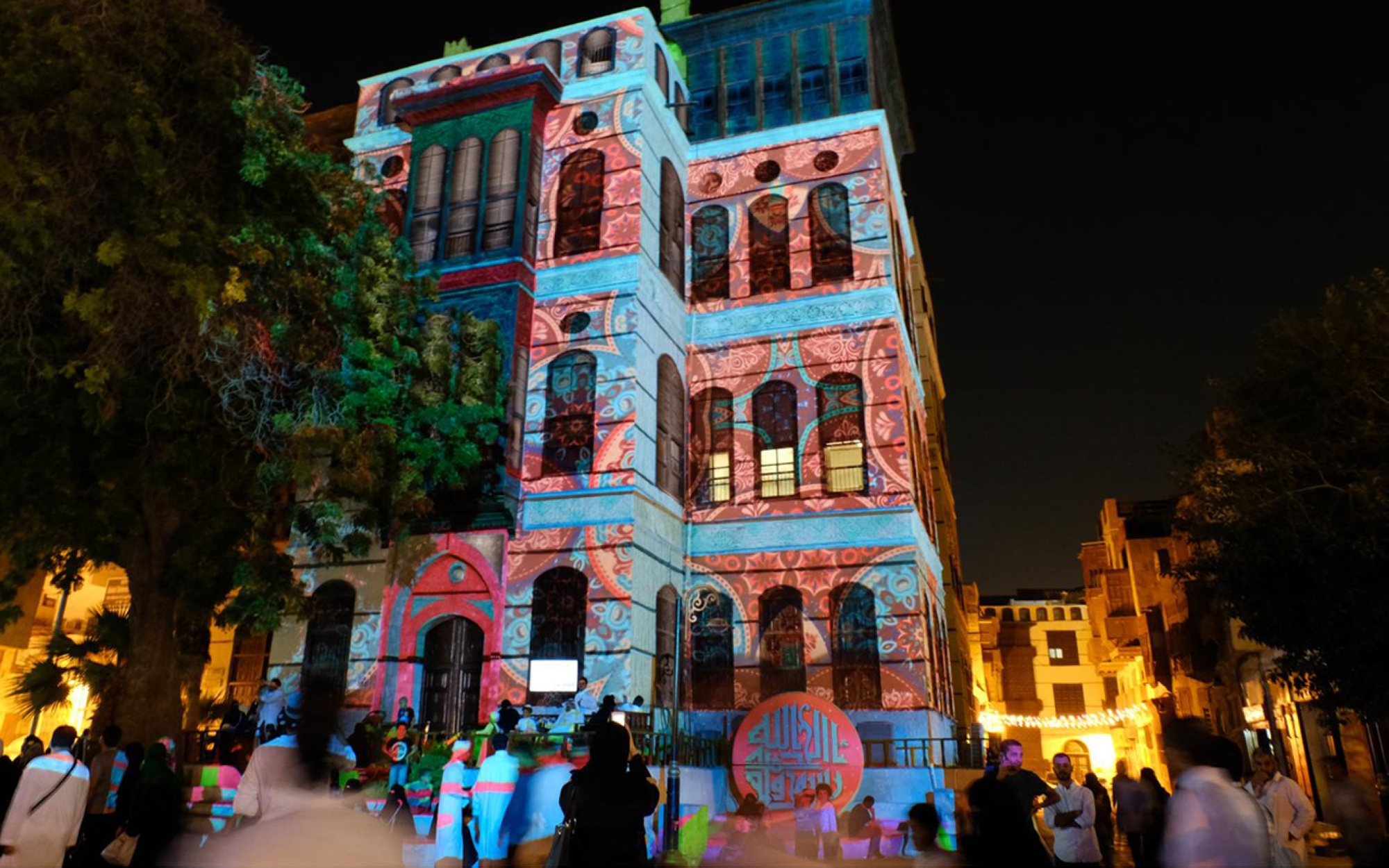
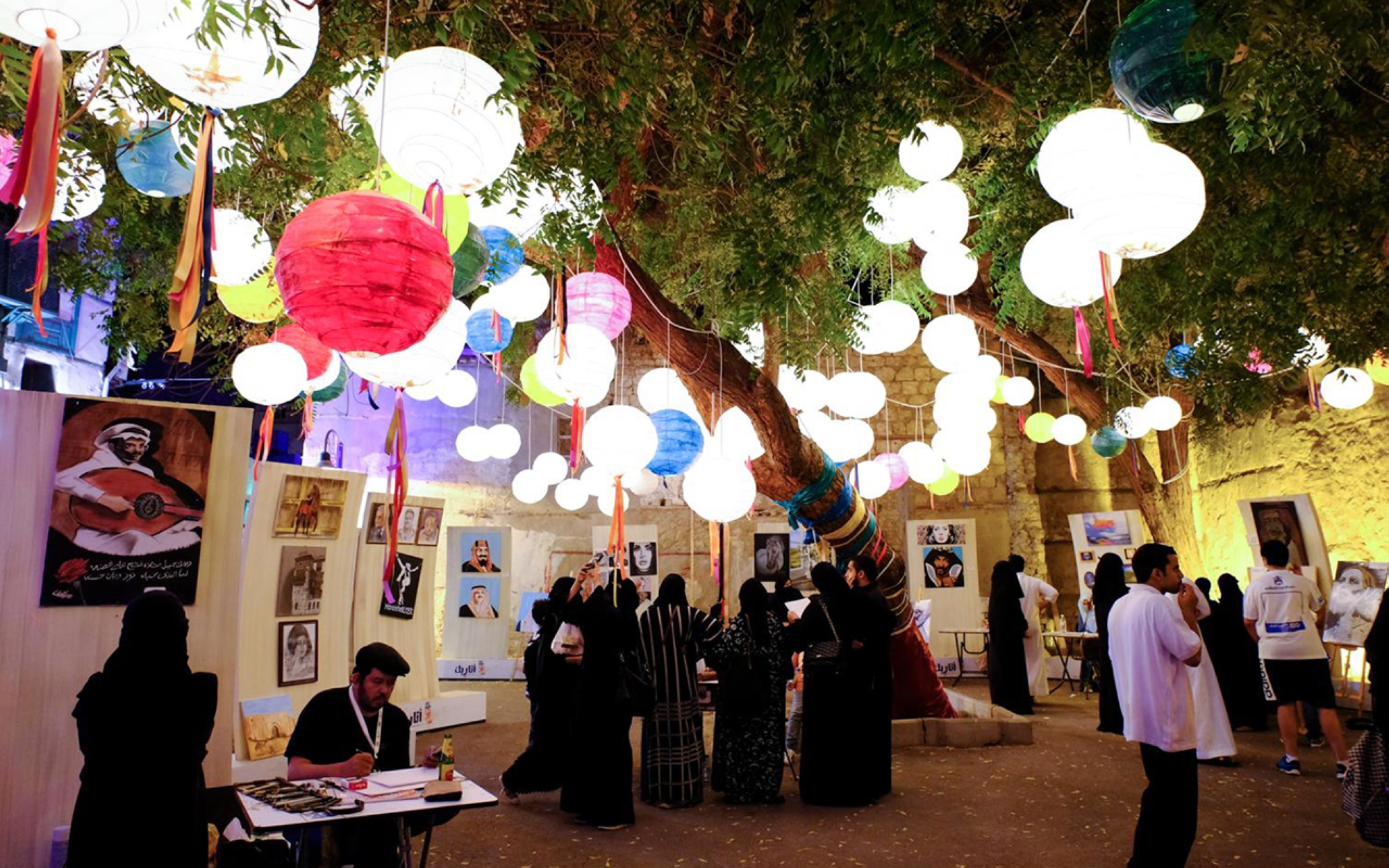
Historic Jeddah is a hotspot for organizing festivals and celebrations, annual cultural and recreational activities, and receiving tourists. It is one of the most attractive sites that Jeddah residents customarily visit in Eid al-Fitr and Eid al-Adha seasons, and during the month of Ramadan. The district annually hosts a cultural heritage festival, the Historic Jeddah Festival, which draws more than half a million visitors.
Historic Jeddah Festival
The maiden round of the Historic Jeddah Festival was launched on January 16, 2014; it is an annual festival that takes its visitors back to the atmosphere city of Jeddah more than half a century ago. The festival aims to strengthen the Kingdom's position as a central source of Arab and Islamic culture, literature, and history; preserve heritage pillars and cultural acquisitions; contribute to connecting the inveterate past with the present; open a window into the tales of the past century for Jeddah visitors; and to familiarize the new generation with the history of this region, and the customs, traditions, and heritage of its people.
The second edition of the festival, held under the slogan Shamsik Ashraqat (Your Sun has Risen) included more than eighty-nine heritage, recreational, cultural, and promotional events, the third edition was launched on June 8, 2016, under the slogan Ramadanuna Keda 3 (This Is How We Celebrate Ramadan), and the fourth edition of the festival was launched on March 29, 2017, under the title Atareek (So This Is Who You Really Are!). In addition, the Prince Mohammed Bin Salman Bin Abdulaziz Foundation (Misk) launched on September 20, 2018, the Tareekhuna Misk (Our History Is Fragrant) occasion, which coincided with the eighty-eighth National Day celebrations of the Kingdom, and included twenty-two culture, knowledge, and entertainment events in a visual environment blending heritage with art and technology.
Since the launch of the Jeddah Season in 2019, a multitude of entertainment and cultural events have been presented in the Historic Jeddah area, including comedy shows at the Red Sea International Film Festival theater.
Red Sea International Film Festival
The Red Sea International Film Festival was inaugurated from its headquarters in the northern district in Historic Jeddah, specifically in Bait Zainal (House of Holland), which is classified as a world human heritage estate. The festival is the first international film festival to be held in the Kingdom; it supports the local film sector and aims to enrich cinematic content locally and across the Arab region.
Museums
Bait Nassif is one of Historic Jeddah's most prominent historical houses because of its historical value that tells the history and heritage of the district. It has been transformed into a museum and a library, and a number of cultural and heritage activities are also held there. Among the museums of Historic Jeddah established by the Ministry of Culture is the Red Sea Museum in the Bab al-Bunt building, featuring rare artifacts, manuscripts, photographs, and books. The museum tells the story of the Bab al-Bunt heritage building, which has an important historical value, as it historically served as the point of contact between the residents of the Red Sea coast and the rest of the world, and a main entry point for pilgrims, traders, and tourists to the city of Jeddah. The museum also contains more than one hundred creative artworks and holds around four temporary annual exhibitions, including educational programs for all age groups.
Furthermore, Historic Jeddah also includes several other museums, such as Matbouli House Museum, located in al-Alawi Market in Harat al-Yemen; Bait al-Balad Museum; as well as the al-Diyafa (Hospitality) Museum, which showcases antiquities over a hundred years old.
Related quizzes
Related articles

